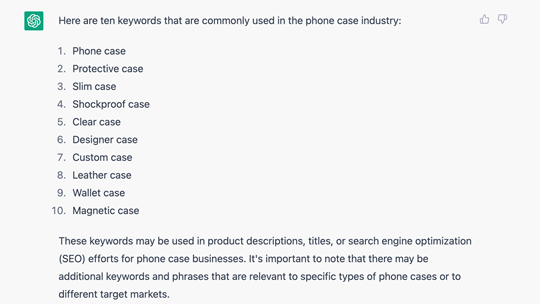How You Can Use ChatGPT & Other AI Technology.
The importance of the human touch
AI technology, in particular ChatGPT, has been a hot topic of conversation. It is unlike any other tool or search engine we’ve seen before, which is extremely exciting, but a little daunting for some.
For many people, especially content writers, artificial intelligence can be a scary thought - endless streams of knowledge available in a matter of seconds, how can any human compete with that?!
The short answer is they can’t, but that’s not a bad thing in the slightest. If you’re a content writer, graphic designer, or anyone else that feels like AI is coming for their job, why not start thinking about how AI can improve your output rather than replace it?
One vital thing that AI will never have is the human touch, an essential and very necessary marketing tool. For a piece of marketing material to be effective, it must leave a mark on the audience so they remember your brand and convert further down the funnel.

What can you use AI for?
As someone who produces ad copy, social content, and blog posts day to day, I’ve found there are some AI technologies I can use to help streamline my work. This allows me to manage my workload efficiently, ultimately allowing me to become more productive.
Keywords
The first thing I have found AI good for is helping plan keyword ideas. Although I wouldn’t recommend using ChatGPT, or any other AI service, as your only keyword source, it can be a useful tool to help kick-start your list.

ChatGPT will use machine learning to help generate generic industry keywords that can help you when you’re starting your keyword research. However, it’s important to remember just because ChatGPT lists them as keywords does not necessarily mean they’re the highest ranking or trending. Therefore we would always recommend performing additional keyword research on sites such as Google Keyword Planner or Semrush.
If I’m ever struggling to come up with keywords for a specific topic, I will ask ChatGPT to generate some and then if any are relevant, they can be used on Semrush/Google Key Word Planner to formulate a proper SEO audit or keyword list.
Blog Structure
Similar to keywords, we would never recommend letting any AI service write an entire blog for you, as previously mentioned, AI will never have the human touch! However, I sometimes find it helpful to see how AI structures a blog on the same topic if I’m struggling to get it to read well or flow correctly. Furthermore, it can sometimes highlight an angle of insight you hadn’t thought of yet which if utilised properly, can help your writing stand out from the rest.

By having another blog on the same topic as a comparison, you can see what works well, and what parts aren’t needed; it can be removed or amended. If you’re struggling to start your blog, it can also be a useful tool to inspire sub-topics.
Market Research
No research will ever be as telling about your customers and target audience as your primary research. However, maybe you don’t have the time or budget to carry out your own, or are just in need of generic top-level research - Artificial Intelligence can help.
An example of a time AI could be useful for market research is using it to predict social media trends. It’s important to note that even though it’s extremely clever, the learning algorithm cannot predict the future for certain, ChatGPT will tell you this for itself.

But this doesn’t mean it’s a blind guess and useless. The predictions are made on previous data, deep learning, and previous trends. Using the same example of social media trends, if ChatGPT uses machine learning to list ten potential trends, that’s ten trends you can begin to research further and see if any align with your business goals and vision.
Reviewing Artificial Intelligence-Generated Content
For a long time, Google’s stance on AI content was clear, low-quality and AI-generated content would be penalised, deterring people from using it.
However, their view on it has updated with the times slightly. Google now states they will specifically target ‘spammy automatically generated content’.
If you are worried about your content sounding too fake before publishing, there are tools available that will check your content, and will give feedback on how it reads and how much AI-written content it believes to be included. These tools are helpful for content writers looking to do a final review before publishing, or educators looking to assess their students' work.
GPT Zero is a popular tool and is worth testing.
Conclusion
The best thing you can do with AI is just to test it. Try and think (within reason) what you think it might be able to do, if it can, great news, if it cannot and it’s an inappropriate request, you learn about the limitations that come with it. It’s simple trial and error.
The beauty of AI is flexibility - there’s no right or wrong way to use it. Everyone’s day-to-day job roles are slightly different, so if you find a use for it that helps make your work more efficient without dropping in quality, then happy days, you’ve learnt how to work with AI! It is just important to remember not to rely on it. Don’t abandon your skillset because you think AI will do it better and quicker.
The more AI develops so too will AI detection. Only humans have the human touch, without it, your marketing will lack identity. Use it!
Whether you work as a copywriter, graphic designer, customer service or any other role. You will never know how useful AI systems can be for you until you embrace it and begin to utilise it. Make AI a part of your skill set rather than trying to compete against it!
Still enjoying the journey?
If you’re still belted up and want to keep reading, here’s another published blog regarding the importance of user experience on your website - The Importance of Iterative User Experience Optimisation.
If you think you’d be inclined to read something else, all our previous blogs can be found by clicking here.